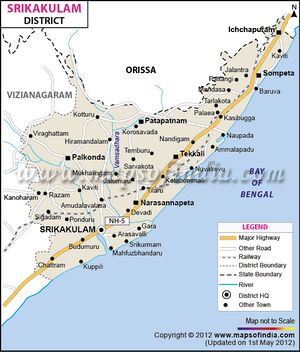Dantapura
| Author:Laxman Burdak, IFS (R) |
Dantapura (दंतपुर) was mentioned as the capital of Kalinga in the epic Mahabharata (5:23). Sahadeva the Pandava general had visited this city. Kalinga is mentioned to have another capital named Rajapura.
Contents
Origin
Variants
- Dantapura (दंतपुर) = Dantapuranagara दंतपुरनगर (AS, p.422)
- Dantapuranagara (दंतपुरनगर) (AS, p.422)
- Dantapuram (दंतपुरम्)
- Dandaguda (Pliny.vi.23)
- Dandagula
- Dandapula
Mention by Pliny
Pliny[1] mentions The Indus....From the mouth of the Ganges to the Promontory of the Calingi and the town of Dandaguda,5 is six hundred and twenty-five miles; from thence to Tropina twelve hundred and twenty-five; from thence to the promontory of Perimula, where is held the most celebrated mart in all India, seven hundred and fifty, and from thence to the city of Patala, in the island just mentioned, six hundred and twenty miles.
5 Probably in the vicinity of the modern Calingapatam; none of the other places seem to be identified.
History
Dantapuram a small village in Srikakulam district. It is a site of great religious and historical significance. Known as Buddhas Tooth at Dantapura, the capital of the Kalingas. While ancient Dantapuram sank into oblivion, Kandy receives tens of thousands of visitors every month. Historians believe it to be the capital of Kalinga Kingdom. Emperor Asoka fought Kalinga War in 261 BC.
The word danta in Telugu language means Tooth. Archaeologists infer that one tooth of Lord Buddha was taken to Kandy in Sri Lanka from Dantapuram.
Dantapura, the reputed capital of ancient Kalingas. There is similarity between Dantavuram and Dantapura of the Buddhist chronicles induces me to identify Dantavuram. This identification is also corroborated by the writings of the ancient Roman geographer, Pliny who mentions about the Calingoe in his Natural History.
Mention by Alexander Cunningham
Alexander Cunningham[2] writes that ....The Calingae are mentioned by Pliny,[3] as occupying the eastern coast of India below the Mandei and Malli, and the famous Mount Maleus. This mountain may perhaps be identified with the high range at the head of the Rishikulya river, in Ganjam, which is still called Mahendra Male, or the " Mahendra mountain." To the south, the territory of the Calingae extended as far as the promontory of Calingon and the town of Dandaguda, or Dandagula,[4] which is said to be 625 Roman miles, or 574 British miles, from the mouth of the Ganges. Both the distance and the name point to the great port-town of Coringa, as the promontory of Coringon, which is situated on a projecting point of land, at the mouth of the Godavari river. The town of Dandaguda, or Dandagula, I take to be the Dantapura of the Buddhist chronicles, which, as the capital of Kalinga, may with much probability be identified with Raja Mahendri, which is only 30 miles to the north-east of Coringa. From the great similarity of the Greek Γ and Π, I think it not improbable that the Greek name may have been Dandapula, which is almost the same as Dantapura. But in this case, the Danta, or "tooth relic," of Buddha must have been enshrined in Kalinga as early as the time of Pliny,
[p.518]: which is confirmed by the statement of the Buddist chronicles, that the "left canine tooth" of Buddha was brought to Kalinga immediately after his death, where it was enshrined by the reigning sovereign, Brahmadatta.[5] Dantapura, also, is said to have been situated on the northern bank of a great river, which can only be the Godavari, as the Kistna was not in Kalinga. This fact alone would be sufficient to fix the position of Dantapura at the old capital of Rajamahendri, which is situated on the north-eastern bank of the Godavari. The name of Mahendri is perhaps preserved in the Pitundra Metropolis of Ptolemy, which he places close to the Maisolos, or Godavari, that is, to the river of Masuli-patam.
दंतपुर = दंतपुरनगर
विजयेन्द्र कुमार माथुर[6] ने लेख किया है ...दंतपुर अथवा 'दंतपुरनगर' (AS, p.422) बंगाल की खाड़ी पर स्थित प्राचीन बंदरगाह था। कुछ विद्वानों ने वर्तमान जगन्नाथपुरी को ही दंतपुर बताया है। मलय प्रायद्वीप के लिगोर नामक प्राचीन भारतीय उपनिवेश को बसाने वाले राजकुमार के विषय में परंपरागत कथा है कि वह मौर्य सम्राट अशोक का वंशज था। वह मगध से भाग कर दंतपुर के बंदरगाह से एक जलयान द्वारा यात्रा करके मलय देश पहुँचा था। वर्तमान जगन्नाथपुरी ही प्राचीन दंतपुर है।
दंतपुर प्राचीन कलिंग के एक नगर का नाम है। यहाँ राजा ब्रह्मदत्त ने बुद्धदेव का एक दांत स्थापित कर एक स्तूप बनवाया था जिससे यह बौद्धों का एक तीर्थ स्थान बन गया। बौद्ध धर्म में प्रचलित इस शब्द का प्रयोग हिन्दी साहित्य में किया गया है।[7]
External links
References
- ↑ Natural History by Pliny Book VI/Chapter 23
- ↑ The Ancient Geography of India/Southern India: By Sir Alexander Cunningham, p.517-518
- ↑ Hist. Nat. vi. 21. "Gentea: Calingae proximo mari, supra Mandei, Malli, quorum mons Mallus, finisque ejus tractus est Ganges."
- ↑ Hist. vi. 23. Philemon Holland's translation has Dandagula.
- ↑ Turnour, Journ. Asiat. Soc. Bengal, 1837, p. 860, quoting the Dantha-dhatu-wanso, or " History of the Tooth-relic.
- ↑ Aitihasik Sthanavali by Vijayendra Kumar Mathur, p.422
- ↑ भारतकोश-दंतपुर
